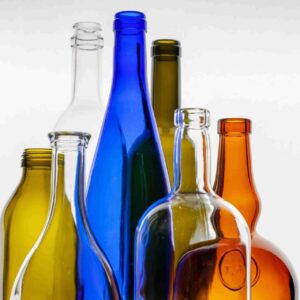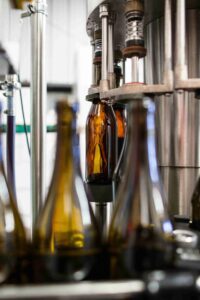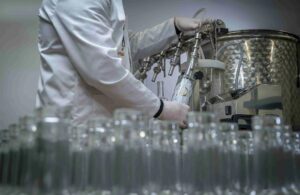Glass bottles and jars emerge as epitomes of both environmental responsibility and elegant design, emphasis on sustainability and aesthetic appeal is paramount. Their translucent charm and eco-friendly nature set them apart in a marketplace teeming with choices. Let’s take a deep dive into the meticulous and detailed process of glass bottles and jars! It’s a story that not only highlights the skill involved in their production but also underscores the commitment to preserving our planet through sustainable practices. In exploring this process, readers will gain an in-depth understanding of how these everyday objects are transformed from raw, earth-sourced materials into the sleek, functional, and aesthetically pleasing products that grace our shelves and lives.
Step 1: Raw Material Assembly
The journey of a glass bottle or jar begins with assembling the raw materials. Predominantly, this includes silica sand, soda ash, limestone, and cullet (recycled glass). The combination of these ingredients forms the basis of the glass.
The raw materials used in the production of glass bottles can significantly influence their color. Here’s how different materials impact the color of the glass.
Generally speaking, the relationship between glass raw materials and color is as follows:
Silica Sand: The primary component of glass, silica sand, is naturally clear. However, impurities in the sand can lead to various colors in the glass.
Iron Contaminants: Iron is a common impurity in silica sand. It typically imparts a greenish tint to the glass, which is often seen in common beverage bottles. The more iron present, the greener the glass.
Soda Ash and Limestone: These ingredients are generally color-neutral, but impurities in these materials can also affect the glass color.
Cullet (Recycled Glass): The color of the cullet used in the glass batch can influence the final color. Mixing cullets of different colors can result in a less predictable final hue.
Colorants and Decolorizers: Manufacturers often add specific metal oxides or other compounds to achieve desired colors. For example, adding cobalt oxide creates blue glass, while manganese produces purple glass. Decolorizers, like selenium or cerium oxide, can counteract the greenish tint from iron impurities to create clear glass.
Other Additives: Different additives can yield a variety of colors. For example, chromium produces green, gold produces red, and copper can produce blue or red tones, depending on other factors in the melting process.
While the basic raw materials of glass (silica sand, soda ash, and limestone) are typically color-neutral, impurities and added colorants significantly influence the color of the final glass product. Glass manufacturers carefully control these factors to produce bottles and jars of specific colors for aesthetic and functional purposes.
Step 2: Batch Preparation
These ingredients are carefully weighed and blended to form a consistent batch. This step is crucial as the quality of the mix determines the clarity and strength of the final product.
Step 3: Melting
The batch is then transferred to a high-temperature furnace, where it’s melted at around 1700°C. This transforms the solid mix into a homogenous, molten state, ready for molding.
Step 4: Forming Bottles and Jars
The molten glass is then shaped into bottles or jars. This is typically done using one of two methods: blow-and-blow for narrow-necked bottles or press-and-blow for jars and wide-necked bottles. Precision during this stage is key to achieving the desired shape and size.
Step 5: Annealing
Post-forming, the glass items enter an annealing lehr, where they are slowly cooled. This controlled process removes stresses and enhances the durability of the glass, ensuring its resilience in everyday use.
Step 6: Quality Assurance
Each bottle and jar are rigorously inspected for defects. This quality control is vital to maintain high standards. Automated inspection systems are commonly used for this purpose, ensuring each product meets the required specifications.
Step 7: Secondary Processing
Finally, additional processes like labeling, painting, or etching may be applied to customize the bottles and jars, tailoring them to specific brands or purposes.
From a meticulous mix of raw materials to the final, elegant product, the creation of glass bottles and jars is a testament to human ingenuity and craftsmanship. Each step in the process plays a pivotal role in ensuring that these containers not only look beautiful but also stand the test of time.













